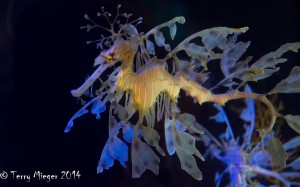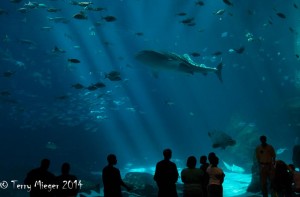Images from the Id – On the Road Or Swimmin’ in the Tank?
As of today we have been on the road for 10 days for a combination family visit and photography trip. Photography-wise the first stop was the Birch Aquarium in La Jolla California. This is a nice, although small aquarium that we have visited for many years. This is tough photography. It’s dark, the glass is not always clear and it’s usually wavy. Focusing is difficult and it seems like many times the iPhone gets a better image. The day we were there the were large groups of school field-trippers and pushy toddlers. My usual philosophy is, they have as much right to look and enjoy the facility as I do. All of these factors influence the ability to get good photographs.
Preparation for a trip to the aquarium. First, look at taking the correct equipment, pick what you will need for the purpose you hope to accomplish. I will usually be looking for the great fish and animal shots but I really like to throw in some “people” shots.. You need to be aware that every public aquarium, zoo or gardens has strict policies governing the use of photographs taken. You must not use any of the images for income unless you pay their fee, which can be quite high. So just use them for your self. If you have a family plan to use the aquarium more as a back drop your activity.
Equipment- most modern cameras handle low light well, some better than others. Use one that does well in low light, higher ISO settings. Take the fastest lens you can. By this I mean one that has a maximum f stop of at least f/2.8. Remember the smaller the number the more the light can get to the sensor. We call this “faster”. The lens should have good vibration reduction (VR on Nikon). Here’s a side note- contrary to what you may have heard, lens stabilization is much better than stabilization in the cameras body. Yes, having stabilization in the camera-body does work with all lenses but having it in the lens has one major advantage, you can actually see it work. I was shooting today and actually could see I forgot to turn the VR on. Back on subject. A good stabilization allows you to shoot at much lower shutter speed. Forget the flash. Most of the time the flash will give nothing but reflections which are a major problem anyway. Using a polarizer would be nice but not practical because of the decrease in light. Learn, I should say practice, good shutter release techniques. You must learn to squeeze the “trigger” Try taking a breath and holding it. You will be amazed how slow of a shutter speed you can handle with stabilization and practice.
At the aquarium, keep checking your settings. Shoot aperture priority, keeping the lens as open as you can considering the depth of field. Your camera should be able to automatically handle the exposure. Shoot RAW. This allows you to “fudge” the exposure a bit to help your shutter speed. You may have to do some manual focusing and that can be difficult. Practice gets better results.
Try shooting something besides just the fish put some people in, especially if they’re family. The people help keep the frustration down and add to your experience and repertoire. Experiment, have fun this should help you to get started and you will get some great results.
Lead Photo – Birch Aquarium La Jolla CA. Sea Dragon, 1/125 sec, f/5.0, -1.0 EV, 3200 ISO!! This d7100 Nikon is great for lower noise at these high ISOs. You also need good noise reduction is this case Lightroom 5.4
Photo #2 Atlanta Aquarium is a great place to photograph fish and people. 1/125 sec, f/5.6, -1 1/3 EV (don’t be afraid of playing with EV) ISO 800 18 mm/27 mm.



